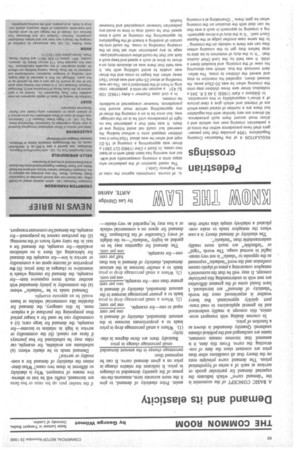Demand and its elasticity
Page 68

If you've noticed an error in this article please click here to report it so we can fix it.
A BASIC CONCEPT of the economist is the "demand curve" which indicates the expected demand for particular goods or services at each of a series of hypothetical prices. The demand curve principle rests on the theory that all conditions other than price are constant since the date of constructing the curve. From this date, it is assumed that incomes remain constant, tastes are unchanged and the political climate unaltered. Quantity demanded is shown as a function of price.
In courses dealing with transport economics, this concept is readily understood and its general applications to road transport quickly appreciated. But heavy weather is experienced once the words "elasticity of demand" are introduced. I have found some of the greatest difficulties are met with in understanding this particular concept. It may well be that the economist's metaphor concerning a piece of elastic causes confusion and the word "inelastic" expressed as the opposite to "elastic" is not very, meaningful in normal usage. The words "rigid" or "inflexible" are much more readily understandable than "inelastic".
The elasticity of demand theory is a case where the Metaphor tends to make complicated a relatively simple idea rather than assist. Price elasticity of demand, to give it the more accurate term, measures the response of the quantity demanded to changes in price. It indicates the relative change in price on a given demand curve. It can be expressed thus: percentage change in the amount demanded small percentage change in price Basically there are three degrees in elasticity: (1). Where a small percentage drop in price leads to a proportionate increase in the amount demanded, elasticity of demand is one per cent equal to one—for example, one per cent; (2). Where a small percentage drop in price leads to a greater percentage increase in the amount demanded, elasticity of demand is greater than one—for example, two per cent
one per cent;
(3). Where a small percentage drop in price leads to a smaller increase in the amount demanded, elasticity of demand is less than half per cent one—for example, one per cent.
The demand for cigarettes may be regarded as highly "inelastic"—to the delight of every Chancellor of the Exchequer. The demand for space on a commercial vehicle or a bus may be regarded as very elastic—
if the haulier puts up his rates or bus fares are increased, traffic will be lost to alternative means of transport. Why is elasticity so different in these two cases? What determines the elasticity of demand for a commodity or service?
Demand tends to be elastic where: (a) substitutes are available, for example, car rides may be substituted for bus journeys if fares are raised; (b) the commodity or service is high in relation to income—for example, the demand for large cars; (c) a commodity can be used for a longer period thus postponing the purchase of a replacement. In this category, the demand for durables like commercial vehicles or buses would be an apposite example.
Demand tends to be "inelastic" where: (a) the commodity is jointly demanded with another much more expensive item—for example, the demand for steering wheels is insensitive to changes in their price; (b) the proportion of income spent on a commodity or service is low—for example the demand for lubricating oil; there is no substitute available—for example, the demand for a taxi in the rainy early hours of the morning; (d) the purchase cannot be postponed—for example, the demand for commuter transport.




















































































































